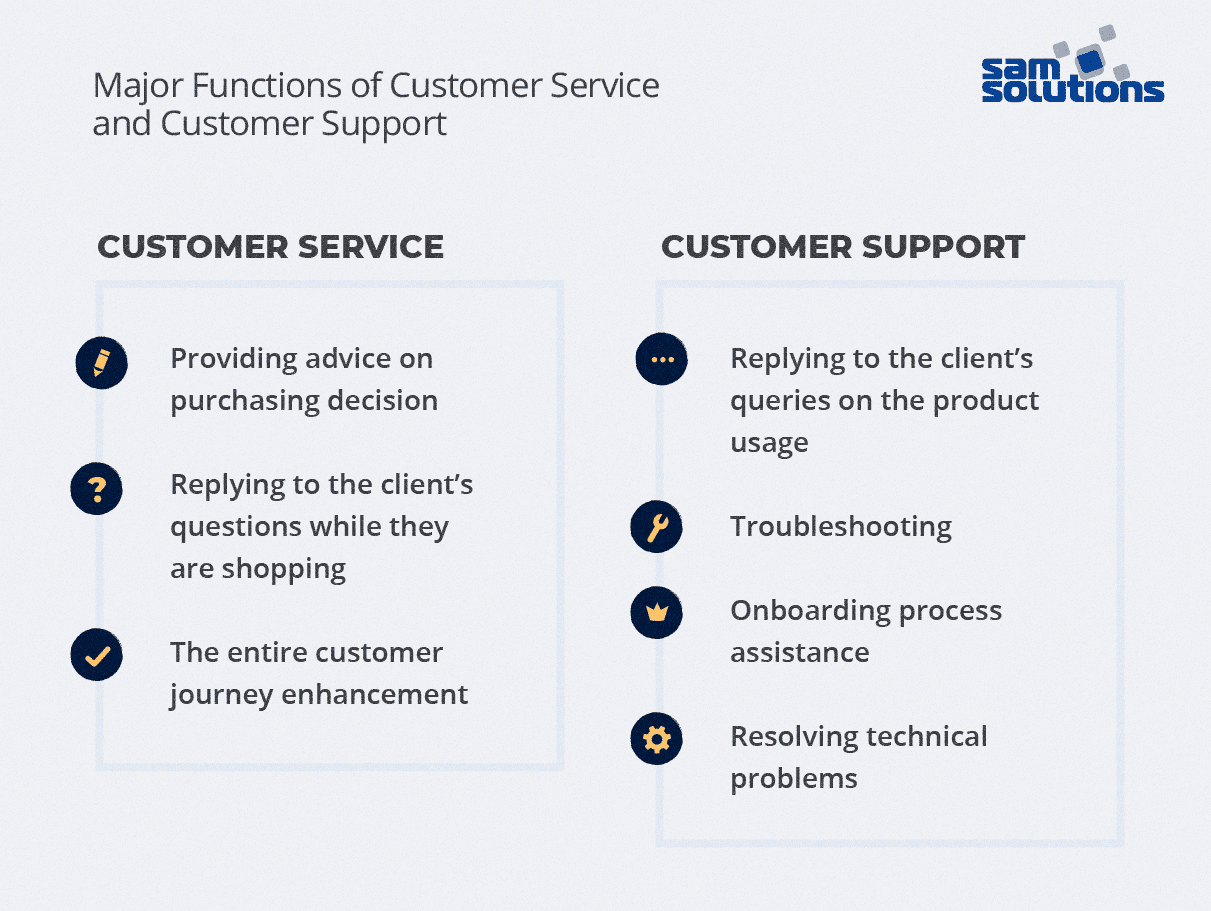High-quality customer support and customer service help businesses create stable connections with clients. Some authors use the expressions customer support and customer service interchangeably, but essentially the terms are not the same. They mean different functions carried out by the customer and the service departments separately. Continue reading this post to discover in which characteristics customer support is different from customer service.
Achieve digital transformation with custom software delivered by SaM Solutions’ seasoned engineers.
What Is Customer Support?
Customer support usually means a range of services that software businesses offer to their clients. These services are mainly concentrated on offering technical help if clients face any difficulties with the company’s products. The support service covers replying to clients’ queries, troubleshooting, assisting with the onboarding process, and resolving any problems that may arise while implementing the company’s product. As a rule, there are special support agents who manage clients’ issues through different channels such as live chats, networks, messengers, or by phone.

What Is Customer Service?
Customer service is the advice or assistance provided by a business to ensure smooth interaction with the client. The service specialists reply to the clients’ questions while they are making purchases, help them make their purchasing decision, and solve other issues with goods like substituting damaged or faulty items. The service specialists act in accordance with software administrative requirements to ensure the clients are happy. Essentially, the objective of customer service is to enhance the entire user journey, ensuring the clients’ satisfaction and their positive feedback.
What’s the Difference between Customer Service and Customer Support?
At first glance, customer service and support may seem similar. However, this is not entirely the case. The terms cannot be used interchangeably even though both exist to provide help to clients. Below you can read the focal points that customer service and customer support do share. They both:
- provide help to the company’s clients
- utilize similar channels to communicate with clients (emails, chats, social networking, Skype and other messenger apps, phone conversations)
- leverage almost the same skills with the aim to enhance customer experience while they are dealing with the company’s products
- play a crucial part in the customer care strategy of the company
- facilitate the company’s competitiveness.
Leverage SaM Solutions’ decades-long expertise in IT to develop high-quality custom software for your business.
However, there are important differences between the concepts. A service department offers numerous services to those who interact with the company; the support department, on the contrary, focuses mainly on supporting the product.
Service is a wide term implying cooperation with the clients at all stages of their interaction with the company, including pre-sales activities, such as giving advice regarding the best choice of product and proper product usage.
Support can be viewed as a subtype of customer service. It primarily deals with resolving issues emerging after the purchase, receiving feedback, and working with technical documentation.
Customer service is client-oriented since its main concern is to leave a positive perception of the experience with the company. Support, on the other hand, is company-oriented, because its major focus is the proper functioning of the company’s products.
The specialists from the support department primarily leverage technical knowledge for solving the client’s issues. Along with IT proficiency, the customer service agents use social and marketing knowledge to guide the clients.
Customer Support vs Customer Service
In order to make the correct choice between customer service and customer support, the initial step should be to differentiate the major characteristics of the two concepts. It is possible to make the comparison between customer service and customer support by what each does for the client. Support agents solve software problems as quickly as possible, sometimes in less than an hour. Contrary to customer support, customer service means long-term communication with clients.
Below you can read about the main characteristics that can help to tell apart customer support and customer service:
| Customer service | Customer support |
| 1. With its main focus on the overall client journey, customer service covers the pre-sales experience, the buying process, and the handling of technical issues after the purchase. | 1. In most circumstances, customer support refers to the after-sales experience: replying to questions, fixing and repairing, assisting with the setup process, and solving any issues that appear during product usage. |
| 2. Client-oriented, as the main objective is to ensure user satisfaction with the product. | 2. Company-oriented, as its major aim is to care about appropriate functioning of the company’s product. |
| 3. The aim is to establish strong trust-based relations with consumers. | 3. The aim is to resolve specific technical problems with products. |
| 4. Along with technical knowledge, the service team also offers non-technical expertise. | 4. Mostly technical expertise is employed. |
| 5. Measures business development metrics (net promoter score, churn, loyalty, and retention rate) and transactional metrics. | 5. Measures only transactional metrics like average handle time, CSAT, first contact resolution, etc. |
| 6. Any business domain, such as banking, insurance, retail, etc. | 6. Mostly SaaS, eCommerce, and tech domains. |
| 7. Includes active interaction with a client, giving advice throughout the client’s communication with the company. | 7. Reactive in nature, as support happens as a response to the client’s query. |
The Role of Customer Support
IT businesses offer support services to solve any software problems the clients may encounter while using the products. The support specialists give advice on how to use the products correctly and efficiently.
Troubleshooting and conflict management are not the only areas of customer support work. Modern IT companies offer complex software solutions, and professional guidance is often needed on a regular basis to ensure proper software functioning.
The support department is also charged with providing consultations to users to help them understand the functionality of products better. They often recommend buying complementary products and inform the clients about the possibility of getting more advanced subscription plans, new features, and other advantages.
The Role of Customer Service
Customer service covers all interactions between a company and a client, with the ultimate goal to enhance client relationships with the brand. To create long-term relationships with clients and improve their loyalty, it’s of utmost importance for businesses to invest in top-notch service.
Professionals from the service team give advice to clients before they buy a product, help them make the right purchase, and provide assistance afterward. The service team provides technical and non-technical recommendations to help resolve any concerns regarding the product.
When companies are able to devote time and money to the development of this sector, their retention rate is improved as a result of more clients’ satisfaction. Given this, they have all the chances to outrun their competitors and boost revenue.
Bonus Tips for Great Customer Service/Support
The following are some useful tips for cutting-edge service/support:

1. The Art of Listening
Don’t rush; let your interlocutors speak and tell about their experiences. People do notice when you listen carefully to their every word and pay attention to their needs. Being all ears, support agents will not miss the small but significant details. Asking questions and being as interactive as possible also leads to better engagement. Let the client’s voice be heard, ask their opinion, and it can reveal new sources for the success of your product.
2. Personalization is Key
Your clients have different levels of background knowledge. Their technical knowledge, perspectives, and education vary. Bearing this in mind, support agents should differentiate their strategy for a young person and a senior citizen, for a technical college graduate, and for a person who doesn’t deal with complex technical tasks on a daily basis. There are people who like to dive deep into the details, and there are those who prefer simple and quick solutions without unnecessary explanations. Make sure that you put your client’s feelings and background first, in order to provide the most individual approach possible.
3. Be Human
Do not forget that you are a person, not a robot. There are support specialists who sound like machines. To establish trust-based relations, talk to your clients in a personable manner. Try putting yourself in their shoes to get a better grasp of your client’s thoughts. Thanks to an empathetic attitude, service workers can provide a comfortable and pleasant experience to the client while resolving their issues.
4. Etiquette
Politeness and gratitude are of pivotal importance while handling support requests. No matter what your domain is, a courteous and kind approach is highly appreciated. Sometimes interactions with clients involve resolving conflict situations and dealing with ill-tempered persons, and it is easy to go over the edge and lose your temper. However, what might seem normal in everyday personal communication can be unacceptable for a professional. I would recommend you to focus on keeping a friendly manner and always express assertiveness while managing requests. Prioritize a respectful attitude over negative emotions, and make the client’s satisfaction your ultimate goal.
5. In-Depth Expertise
To provide high-quality support, successful specialists always learn new things and enhance their expertise. Support managers can schedule regular training sessions for the staff, and provide detailed instructions, templates, and handy manuals for newcomers. You should also make sure that your staff are aware of recent product updates and IT innovations, and that they keep up with the latest market trends.
6. Sky’s the Limit
There is always room for perfection. In order to reveal the areas for improvement, ask your clients to share their reviews of service/support. You can create interactive questionnaires to make the process of submitting reviews and assessments easier. Users can also express their thoughts about your organization and discuss their own work and purchasing behavior, which can serve you as advice on how to enhance the client’s journey.



























 5 Reasons Why Your Business Needs a Mobile eCommerce Application
5 Reasons Why Your Business Needs a Mobile eCommerce Application Using Salesforce to Improve Your Sales Pipeline: Five Tips
Using Salesforce to Improve Your Sales Pipeline: Five Tips Cross-Platform Mobile Development: Five Best Frameworks
Cross-Platform Mobile Development: Five Best Frameworks How to Develop Custom Accounting Software
How to Develop Custom Accounting Software 10 Best Web Development Frameworks in 2024
10 Best Web Development Frameworks in 2024












 Top 30 Ecommerce Tools to Elevate Your Business in 2024
Top 30 Ecommerce Tools to Elevate Your Business in 2024 5 Best Tools to Improve Embedded Software Testing
5 Best Tools to Improve Embedded Software Testing Why React and Node.js Are the Top Technologies for Creating High-Performance Web Apps in 2024
Why React and Node.js Are the Top Technologies for Creating High-Performance Web Apps in 2024 10 Best IoT Platforms for 2024
10 Best IoT Platforms for 2024
In my opinion, these terms can be used interchangeably, if we’re talking about helping customers with a product that they have already bought. If they haven’t purchased it yet, then it will be customer service and not customer support. This is how I understand it.
I once called customer support to help me with malfunctioning software. The guy would not stop talking for a second. He didn’t let me get a word in and used complex technical terms I couldn’t understand. If only all support specialists were polite and used a personalized approach!
Well done! With these awesome bonus tips, any business can set up great customer support. As a customer support manager, I am eager to implement these recommendations in my department.
The chart was of great help to me. I like structured information, and the visual representation makes it much easier to grasp the main idea and remember the focal points.
I think customer support is extremely important for any business. When I deal with rude customer support staff, I always stop using their services and switch to other service providers. This has happened a couple of times.